What should Ms. Rollison know about behavior in order to help Joseph?
Page 2: Learning Key Behavior Principles
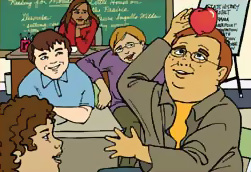 As we discussed on the previous page, consequences can either increase or decrease the probability that a student’s behavior will reoccur. Of course, it is not always easy to know what effect a consequence will have until teachers are able to observe future behavior. For example, a teacher might assume that keeping a student in at recess will decrease an unwanted behavior. However, the actual effect of the consequence cannot be determined until he or she can observe whether the behavior does, in fact, decrease. Teachers who effectively change student behavior frequently use one of the following types of consequences:
As we discussed on the previous page, consequences can either increase or decrease the probability that a student’s behavior will reoccur. Of course, it is not always easy to know what effect a consequence will have until teachers are able to observe future behavior. For example, a teacher might assume that keeping a student in at recess will decrease an unwanted behavior. However, the actual effect of the consequence cannot be determined until he or she can observe whether the behavior does, in fact, decrease. Teachers who effectively change student behavior frequently use one of the following types of consequences:
- Positive reinforcement
- Negative reinforcement
- Punishment
- Extinction
Positive Reinforcement
Positive reinforcement is a means by which teachers can increase the probability that a behavior will occur in the future. A teacher uses positive reinforcement when he or she provides something that is pleasant. Positive reinforcement is often thought of as a reward.
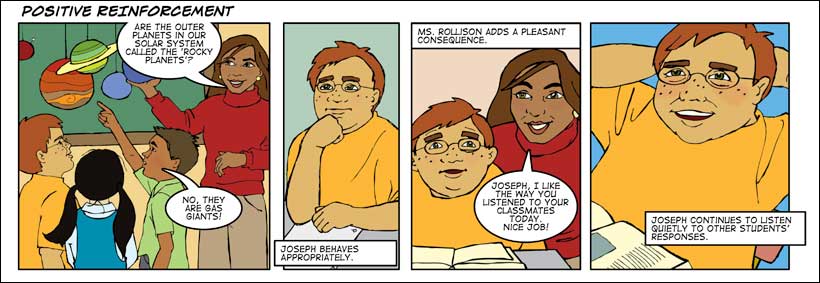
- First Panel: Ms. Rollison is showing her students, including Joseph, some models of the planets in our solar system.
- Ms. Rollison: Are the outer planets in our solar system called the “rocky planets”?
- Student #1: No, they are gas giants!
- Second Panel: Joseph quietly watches this exchange.
- Caption: Joseph behaves appropriately.
- Third Panel: An appreciative Ms. Rollison smiles at Joseph.
- Caption: Ms. Rollison adds a pleasant consequence.
- Ms. Rollison: Joseph, I like the way you listened to your classmates today. Nice job!
- Fourth Panel: Joseph is pleased by his teacher’s praise. He smiles to himself.
- Caption: Joseph continues to listen quietly to other students’ responses.
Negative Reinforcement
Negative reinforcement is also a means by which teachers can increase the probability that a behavior will occur in the future. A teacher uses negative reinforcement when he or she removes something that is unpleasant. Negative reinforcement is often thought of as relief from something aversive (e.g., boring class work).
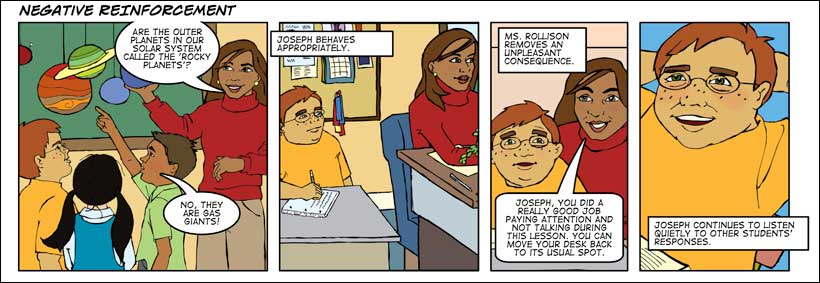
- First Panel: Ms. Rollison is showing her students, including Joseph, some models of the planets in our solar system.
- Ms. Rollison: Are the outer planets in our solar system called the “rocky planets”?
- Student #1: No, they are gas giants!
- Second Panel: Joseph quietly watches this exchange from his desk, which is very near his teacher’s.
- Caption: Joseph behaves appropriately.
- Third Panel: An appreciative Ms. Rollison smiles at Joseph.
- Caption: Ms. Rollison removes an unpleasant consequence.
- Ms. Rollison: Joseph, you did a really good job paying attention and not talking during this lesson. You can move your desk back to its usual spot.
- Fourth Panel: Joseph is pleased by his teacher’s praise. He smiles to himself.
- Caption: Joseph continues to listen quietly to other students’ responses.
For Your Information
When you reflect on the concept of reinforcement, do not mistakenly associate the terms positive and negative with the concepts of good and bad. Rather, keep in mind that these terms refer to the addition or removal of a stimulus or condition in order to achieve a desired response. It might be helpful to think of positive reinforcement as a reward and negative reinforcement as a relief; both result in an increase in the probability that the behavior will reoccur.
Positive Punishment
Positive punishment is a means by which teachers can decrease the probability that a behavior will occur in the future. A teacher uses positive punishment when he or she provides something that is unpleasant.

- First Panel: Ms. Rollison is showing her students, including Joseph, some models of the planets in our solar system.
- Ms. Rollison: Are the outer planets in our solar system called the “rocky planets”?
- Student #1: No, they are gas giants!
- Second Panel: Joseph finds this funny. He laughs.
- Caption: Joseph exhibits unwanted behavior.
- Joseph: It must be stinky with all those gassy giants out there!
- Third Panel: Ms. Rollison is upset by Joseph’s disruption.
- Caption: Ms. Rollison adds an unpleasant consequence.
- Ms. Rollison: Joseph, I want you to write ‘I will not make rude comments in class’ twenty times.
- Fourth Panel: Joseph is embarrassed! He puts a hand over his mouth to keep from shouting out in class again.
- Caption: Joseph refrains from making further inappropriate comments.
Negative Punishment
Negative punishment is also a means by which teachers can decrease the probability that a behavior will occur in the future. A teacher uses negative punishment when he or she removes something that is pleasant. “Time-out,” for example, is a commonly used form of negative punishment.
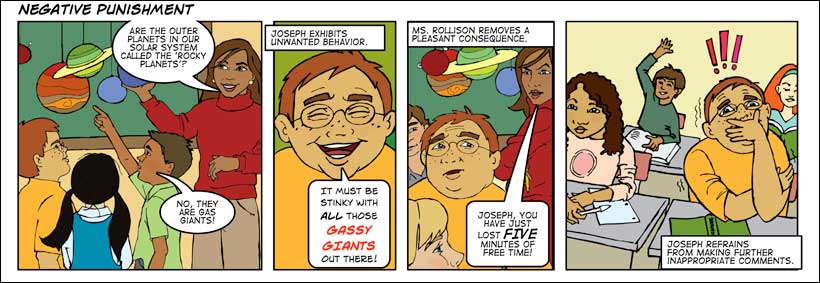
- First Panel: Ms. Rollison is showing her students, including Joseph, some models of the planets in our solar system.
- Ms. Rollison: Are the outer planets in our solar system called the “rocky planets”?
- Student #1: No, they are gas giants!
- Second Panel: Joseph finds this funny. He laughs.
- Caption: Joseph exhibits unwanted behavior.
- Joseph: It must be stinky with all those gassy giants out there!
- Third Panel: Ms. Rollison is upset by Joseph’s disruption.
- Caption: Ms. Rollison removes a pleasant consequence.
- Ms. Rollison: Joseph, you have just lost five minutes of free time!
- Fourth Panel: Joseph is embarrassed! He puts a hand over his mouth to keep from shouting out in class again.
- Caption: Joseph refrains from making further inappropriate comments.
The use of punishment to change behavior runs contrary to most schools’ philosophies, and is not recommended. It is usually more productive to use positive reinforcement to increase a desired behavior than it is to use punishment to decrease an undesirable one.
Extinction
Extinction refers to the withholding of something that is pleasant in order to eliminate the likelihood that a behavior will occur in the future.
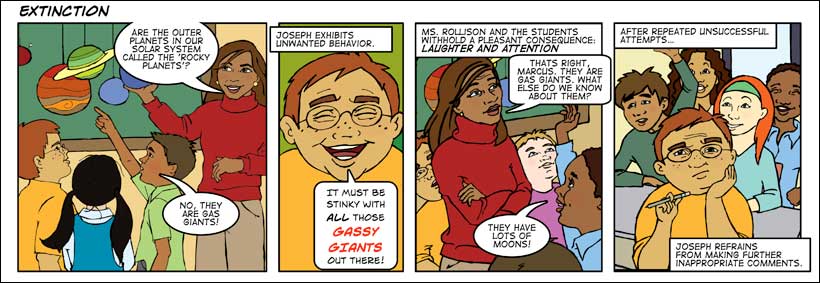
- First Panel: Ms. Rollison is showing her students, including Joseph, some models of the planets in our solar system.
- Ms. Rollison: Are the outer planets in our solar system called the “rocky planets”?
- Student #1: No, they are gas giants!
- Second Panel: Joseph finds this funny. He laughs.
- Caption: Joseph exhibits unwanted behavior.
- Joseph: It must be stinky with all those gassy giants out there!
- Third Panel: Ms. Rollison and Joseph’s fellow students pointedly ignore his outburst. Ms. Rollison continues her lesson.
- Caption: Ms. Rollison and the students withhold a pleasant consequence: laughter and attention.
- Ms. Rollison: That’s right, Marcus. They are gas giants. What else do we know about them?
- Marcus: They have lots of moons!
- Fourth Panel: Joseph’s behavior has failed to get the response he expected. After a while, he lapses into silence.
- Caption: After repeated unsuccessful attempts, Joseph refrains from making further inappropriate comments
Extinction is often difficult to use on its own in a classroom because it:
- Does not produce a quick change in behavior
- Depends on the ability to control all sources of reinforcement (e.g., peer laughter)
- Often results in an extinction burst, a situation in which the behavior gets worse before it gets better. Consider a student who yells out answers to the teacher’s questions without raising her hand. A teacher who decided to put this behavior on extinction would refrain from responding to the student’s comments. In an extinction burst, the initial ignoring is followed by an increase in the rate of talking out as the student tries even harder to get the teacher’s attention. The talking-out behavior may even escalate to yelling or other extreme behaviors.
- Is susceptible to spontaneous recovery, instances in which previously extinguished behavior reappears unexpectedly
If a teacher chooses to use extinction, it should be paired with positive interventions, as described later in this module. Please note that extinction should not be used with difficult or dangerous behaviors.